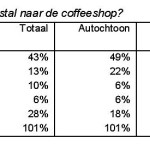The Science Of Twins And The Human Fascination With Them
No Comments yet
Nancy Segal, professor of psychology, Cal State Fullerton
Fascination with twins and what twin studies tell us about human nature is universal. There is no question that behavioral and medical science advances have happened largely because twins yield a wealth of information just by being themselves.
Twin research takes place at two levels:
(1) Studies that are strictly for twins. Such studies examine the pros and cons of twins being separated at school, dressing alike, or sharing their friends.
(2) Studies with broad implications. Psychological analyses and medical research are conducted to understand the genetic and environmental factors affecting behavior and health which can be applied to the general nontwin population.
Twin Types
There are two main types of twins: Monozygotic (MZ, identical) and Dizygotic (DZ, fraternal). MZ twins share all their genes having split from a single fertilized egg within the first two weeks following conception (there are exceptions). DZ twins share half their genes, on average, having formed from the separate fertilization of two eggs released simultaneously. There are, however, variations within each type. For example, there are MZ twins who show mirror-image reversals and DZ twins with different fathers.
Twin Methods
The classic twin study is simple and elegant. Researchers compare the similarities and differences of identical twins to those of fraternal twins. The greater resemblance between identical twins than between fraternal twins is consistent with the view that genetic factors influence the behavioral characteristic or physical trait under study. Of course, environmental influences also affect every measured trait.
There are variations on the classic twin method, two of them being twins reared apart and twins as couples. Identical twins reared apart offer pure estimates of genetic influence given that they share all their genes, but not their environments. Fraternal twins reared apart offer informative contrasts. Twins as couples focus on the quality and outcomes of twins’ social interactions as the twins work together on a joint project or task. Comparing identical and fraternal twins in this regard tells us about the factors contributing to cooperative or competitive social exchanges.
Research
The research described below is located at the juncture of developmental psychology, behavioral genetics, and evolutionary psychology, with a focus on twin studies. Developmental psychology is concerned with the biological and environmental events, both before and after birth, that underlie changes in intellectual and physical growth. Behavioral genetics (BG) examines genetic factors affecting intelligence, personality, interests, and other measured traits. BG is concerned with variation within groups. Evolutionary psychology (EP) is concerned with how and why the mind is designed the way it is, and how this design, together with environmental events, produces behavior. EP is concerned with human universals. Twin research can assess behavioral-genetic and evolutionary-based hypotheses and questions.
Twins Reared Apart
Identical twins reared apart—the rare “elite pairs” among multiples because they cleanly separate genes and experience—have revealed genetic effects on intelligence, personality, interests, and more. One of the most striking findings from the investigators of the Minnesota Study of Twins Reared Apart is that the personality traits of reared-apart identical twins are as similar as the personality traits of reared-together identical twins. This suggests that personality similarity among family members living together is explained by their shared genes, not their shared environments. I also conducted a study of the relationships formed by reared-apart twins, with hypotheses generated by the evolutionary psychological concept of kin selection discussed by W.D. Hamilton. Natural selection favors genes predisposing individuals to act in ways that favor the transmission of those genes. Hamilton reasoned that close relatives should be predisposed to act more altruistically toward one another than distant relatives, given the perception of similarities associated with shared genes.
Mirroring what we see in twins reared together, identical reared-apart twins generally form closer ties than fraternal twins reared-apart twins. This is likely due to their perceptions of resemblance. Most striking, however, is that twins as a group feel closer to their newly found twin than to the adopted sibling they were raised with since childhood. Here, a perceived lack of resemblance may contribute to this result, consistent with what kin selection would predict.
Reared-apart twins’ unusual matching habits are not random events, but likely reflections of who they are. Separated twins have been observed to divide their toast into four square pieces, leaving one section uneaten; twins have been observed to enjoy typically hot drinks at lukewarm temperatures; twins who named their sons James Allan and James Alan have been seen. There are also twins who both used a rare Swedish toothpaste called Vademecum, twins who scratched their ears with a paper clip, and twins who dried their hands with three paper towels in public restrooms. These unusual behaviors were acquired independently by the twins before they knew they were part of a pair. These observations suggest that our own idiosyncrasies and signature quirks arise from a multitude of individually based factors expressed within the environments we seek.
Evolutionary Psychology and Behavioral Genetics: Fruitful Union or Ships Passing in the Night?
EP and BG have operated separately for too long. The reason for this separation is that BG focuses on individual behavioral differences within human groups and EP examines universal human behaviors. However, session panelists for a symposium under this title asserted that BG offers EP informative research designs for assessing evolutionary-based hypotheses and questions, especially those involving kinship relations. Similarly, EP offers BG information for understanding why some behaviors show greater genetic influence than others. There is evidence that these two disciplines are coming closer together, albeit slowly.
By Nancy L. Segal, PhD
Author Bio: Dr. Nancy L. Segal is a professor of psychology at California State University, Fullerton, and the founder and director of the Twin Studies Center. She is the author of nine books on twin-related topics and is currently at work on her tenth. Ongoing twin studies in her laboratory include the behaviors of young Chinese twins reared apart (due indirectly to China’s former One-Child Policy), tacit coordination, behavioral problems, family relationships, and bereavement. Please visit her website at drnancysegaltwins.org to obtain her books on twin-related topics, as well as to participate in research on twins.
Source: Human Bridges
Credit Line: This article was produced by Human Bridges.
You May Also Like
Comments
Leave a Reply







